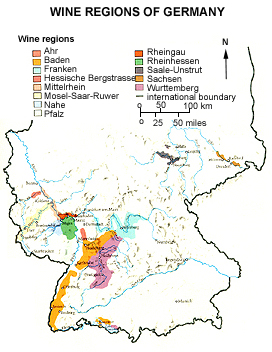| |



Winemakers are reacting to the market, and producing new styles of wine based on low yields from vines of a reasonable age and from botrytis free grapes. Ecologically friendly forms of viticulture are in use, including green manuring and a restricted programme of spraying.
To satisfy the preference of the younger German generation for light, lively, drier, fruity wines, the use of chemicals - other than limited amounts of sulphur dioxide - has been largely replaced by a better cellar procedure. Ageing in new wood, particularly for the Burgunder wines and those of similar structure, is common. Whether this improves the wine or merely changes its style is debatable.
The presentation of the newer wines is sometimes original and occasionally elegant. The Mosel-Saar-Ruwer and Rheingau in particular have taken to taller, more distinguished versions of the traditional slim German bottle, often in an almost black shade of green.
|
|
|
|





